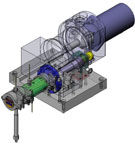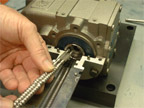- Use for twin screw testing, sample production, research, instruction and training.
- Realistic and scaleable co-rotating twin screw operation.
- Low volume materials requirements - 50 to 200 gr/hr.
- Fully configured co-rotating twin screw - many screw geometries and materials of construction available.
- Control system - wireless../internet/..remote.
- Barrel and die are jacketed for thermal process conditioning [heating or cooling].
- Multiple solids feed ports, liquid injection port and vent/vacuum port.
- Variable speed hydrostatic drive system, remotely located hydraulic power unit - power requirement of 110 volts.
- Quick open, easily cleaned and disassembled.
- Portable-can be placed in hood - weighs about 40 lbs.-ex remote hydraulic power unit
- Multiple extrusion die configurations available.
- Available auxiliaries:
Micro solids & liquid feeders
Mini vacuum systems
Mini heating and/or cooling units
Grinders / Chill rolls / Pelletizer
|
|
||
|
|
Related Links |
|
|
Products & Solutions | Our Commitment | Our Company Copyright MPR 2004 Have not found what you are looking for? Contact us for more information. |
||





